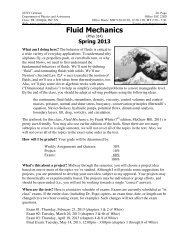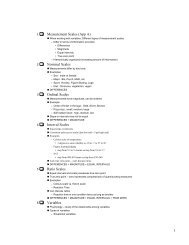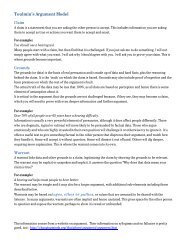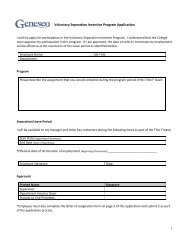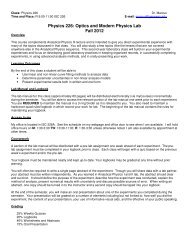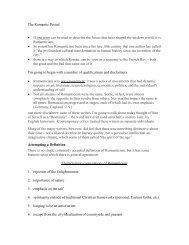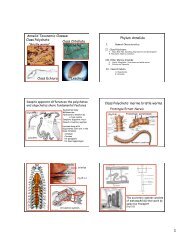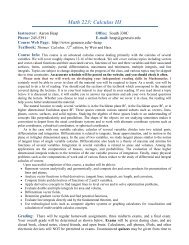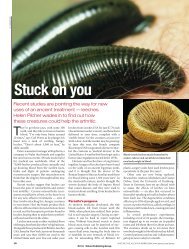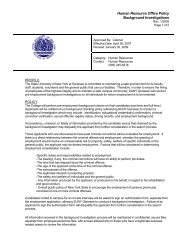Phylum Onychophora : Characteristics of the Onychophora Annelid ...
Phylum Onychophora : Characteristics of the Onychophora Annelid ...
Phylum Onychophora : Characteristics of the Onychophora Annelid ...
You also want an ePaper? Increase the reach of your titles
YUMPU automatically turns print PDFs into web optimized ePapers that Google loves.
<strong>Phylum</strong> <strong>Onychophora</strong> :<br />
• 80 or so species <strong>of</strong> rare animals<br />
• 1.5 to 15 cm in length<br />
• Found in moist places, tropical and So. temperate regions<br />
• Evolved by <strong>the</strong> Cambrian<br />
<strong>Characteristics</strong><br />
<strong>of</strong> <strong>the</strong><br />
<strong>Onychophora</strong><br />
No external segmentation<br />
Hallucigenia<br />
<strong>Annelid</strong>-Like<br />
Extensible Walking legs<br />
Arthropod-like<br />
-Thin flexible outer cuticle - Growth by ecdysis<br />
- Continuous muscles - Chitinous claws on leg tips<br />
- Fluid filled body cavity - Chitinous jaws<br />
- Appendages unsegmented - Open circulatory system<br />
- Segmental excretory - Trachea, spiracular system<br />
tubes like metanephridia<br />
Is <strong>Onychophora</strong> <strong>the</strong> “missing link”<br />
between Arthropods and <strong>Annelid</strong>s?<br />
Is segmentation homologous in arthropods and annelids?<br />
PanArthropoda<br />
<strong>Phylum</strong> Arthropoda<br />
Chelicerata<br />
(75,000)<br />
Insecta<br />
~ 1 million<br />
Crustacea<br />
45,000<br />
Myriapoda<br />
(13,000)<br />
I. Extant Arthropod Diversity<br />
Sub <strong>Phylum</strong> Mandibulata<br />
Crustacea<br />
Insecta<br />
Myriapoda<br />
Sub <strong>Phylum</strong> Chelicerata<br />
<strong>Phylum</strong> probably contains 5 million species<br />
<strong>of</strong> which 1 million have been described<br />
1
Class Crustacea<br />
Sub Class Malacostraca<br />
Class Insecta<br />
Class Myriapoda<br />
Sub Class Chilopoda<br />
Sub Class<br />
Copepoda<br />
Sub Class Cirripidea<br />
Sub Class Branchiopoda<br />
Sub Class Diplopoda<br />
Sub <strong>Phylum</strong> Chelicerata<br />
Most Significant Character: Exoskeleton<br />
Epicuticle is <strong>of</strong><br />
lipids and<br />
lipoproteins<br />
Class Merostomata<br />
Class Arachnida<br />
endocuticle<br />
Chitin is high MW<br />
Nitrogenous<br />
mucopolysaccheride<br />
Class Pycnogonida<br />
Fig 14.1<br />
Hardness from<br />
scleratized<br />
proteins or from<br />
calcium carbonate<br />
in Crustacea<br />
Advantages and constraints <strong>of</strong><br />
<strong>the</strong> exoskeleton<br />
Advantages:<br />
But <strong>the</strong>re are some constraints<br />
Limitations on movement?<br />
• Protection from injury and physiological stress<br />
• Barrier against osmotic and ionic gradients<br />
• Support<br />
• Attachment for muscles<br />
• Elaborated as a variety <strong>of</strong> structures:<br />
wings, bristles, antennas, eyes, auditory organs,<br />
outer shields, jaws, beaks, pincers, paddles<br />
2
But <strong>the</strong>re are some constraints<br />
Hydrostatic skeleton is <strong>of</strong> no use<br />
Reduction <strong>of</strong> coelom: main body cavity is hemocoel<br />
But <strong>the</strong>re are some constraints<br />
How to increase body size?<br />
Arthropod<br />
Growth pattern<br />
Tissue<br />
growth<br />
Growth is by molting<br />
(ecdysis) with tissue<br />
size gains occurring<br />
during <strong>the</strong> intermolt<br />
period<br />
Blood flow:<br />
tissue sinuses venous blood gills<br />
aortas heart<br />
III. Structural/neurobiochemical aspects <strong>of</strong> molting<br />
Review <strong>of</strong> <strong>the</strong> molting process in insects<br />
all arthropods<br />
have “molt lines”<br />
I.e. a line <strong>of</strong><br />
weakness<br />
on <strong>the</strong> shell<br />
Control <strong>of</strong> Molting: Crustacea (Insects Later)<br />
X-organ produces <strong>the</strong><br />
molting inhibition hormone<br />
MIH stored in sinus gland<br />
Control <strong>of</strong> Molting in Crustacea<br />
Appropriate Stimulus<br />
CNS inhibits MIH<br />
Production by X-organ<br />
Sinus<br />
gland<br />
X organ<br />
Y- organ in <strong>the</strong> head <strong>of</strong> <strong>the</strong><br />
animal produces ecdysone<br />
Ecdysone initiates molting<br />
Drop in<br />
Blood MIH<br />
Y-organ produces ecdysone<br />
Molting Initiated<br />
X organ exercises a negative control on molting<br />
3
IV. Tendencies in Evolution <strong>of</strong><br />
Arthropod Body Plan<br />
• Segmentation- when pronounced it is generally<br />
considered an ancestral condition<br />
O<strong>the</strong>r Tendencies in Evolution <strong>of</strong><br />
Arthropod Body Plan<br />
• Segmentation- when pronounced it is generally<br />
considered an ancestral condition<br />
• Tagmosis - tendency to organize segments into regions<br />
having similar structure, function and appendages<br />
Remipidea: blind Crustacea that live in sea caves head<br />
followed by trunk with about 32 identical segments<br />
O<strong>the</strong>r Tendencies in Evolution <strong>of</strong><br />
Arthropod Body Plan<br />
• Segmentation- when pronounced it is generally<br />
considered an ancestral condition<br />
• Tagmosis - tendency to organize segments into regions<br />
having similar structure, function and appendages<br />
• Cephalization - in early arthropods <strong>the</strong> head was scarcely<br />
distinguishable; <strong>the</strong> development <strong>of</strong> a strong sensory,<br />
feeding, cephalic region is a common <strong>the</strong>me in <strong>the</strong> various<br />
groups.<br />
Model<br />
Ancestor<br />
was<br />
trilobite<br />
like<br />
The elaboration <strong>of</strong> <strong>the</strong><br />
head has taken<br />
different courses in <strong>the</strong><br />
major groups but are<br />
still considered to show<br />
“serial homology”<br />
A=antenna<br />
a=acron<br />
C=chelicera<br />
Ci= Chilarum<br />
L = leg<br />
Mnd =Mandible<br />
Mx = maxilla<br />
P= pedipalp<br />
0 =nephridia<br />
Serial homology is <strong>the</strong> concept that initially existing structures<br />
were gradually modified via discrete intermediary steps until such<br />
time as an evolutionary novelty (e.g., jaws) appeared.<br />
Many examples <strong>of</strong> serial homology, e.g. <strong>the</strong> body segments <strong>of</strong> many<br />
animals (vertebrates, arthropods etc), are examples <strong>of</strong> gene<br />
duplication on regulatory genes such as homeobox genes, followed<br />
by evolution differentiating <strong>the</strong> duplicated genes.<br />
4



